News Release

NPS Photo
|
Subscribe
|
Haleakalā National Park News Release
For Immediate Release: January 7, 2022
Contact: Jin Prugsawan, e-mail us
Recent Nēnē Fatalities Serve as a Call to Slow Down and Watch Out for Wildlife on Roadways
Kula, Maui— The new year has been a tough start for nēnē at Haleakalā National Park; over the past few weeks two nēne have been fatally struck by vehicles. The latest nēnē death was reported early this morning just after midnight near the Summit District park entrance station.
Park wildlife biologists noted the nēnē killed was a female and observed a lone male nēnē calling out and vocalizing nearby. The lone male nēnē is presumed to be the mate of the dead female nēnē.
“During nesting season, when a nēnē loses its mate it usually results in total failure for that nēnē family. Any goslings that need rearing are likely to perish without both of its nēnē parents,” said Wildlife Biologist Joy Tamayose. “It may have a chance to find a mate before the next nesting season to try again, but we have observed that nēnē usually do not find another mate for the remainder of the nesting season,” Tamayose said.
The other nēnē fatality during this year’s nesting season occurred on the evening of December 23, 2021, near the Headquarters Visitor Center just below the flashing nēnē crossing sign, which warns motorists to slowdown and look out for wildlife on the road. The nēnē struck was the male of the park’s first reported nesting pair with goslings in the 2021–2022 nesting season. The goslings have since died.
Nēnē nesting season occurs from October to May. Weather conditions at the summit of Haleakalā such as wind, rain, and poor visibility can make spotting nēnē difficult. Motorists can protect nēnē and other wildlife by:
- Following speed limits and driving with caution, especially near the park entrance and Headquarters Visitor Center.
- Looking out for wildlife on roadways. If you stop for wildlife, turn on your hazard lights and allow the animal to completely move off the road before continuing to drive.
- Planning like a park ranger and giving yourself plenty of time to make it to your destination in or outside of the park. This is especially important when driving at night for sunrise or sunset.
- Keeping wildlife wild by not feeding them. Feeding wildlife attracts them to hazardous locations like roadways or parking lots and can put them in dangerous situations.
- Inspecting the area around your vehicle for wildlife, especially underneath or behind your vehicle, before exiting a parking space.
To report injured nēnē or other wildlife in Haleakalā National Park, call 808-985-6170. If outside the park, call the Hawaii Department of Forestry and Wildlife at 808-984-8100. To learn more about nēnē, visit www.nps.gov/hale/learn/nature/haleakala-nene.htm.
---NPS---
Last updated: January 7, 2022
